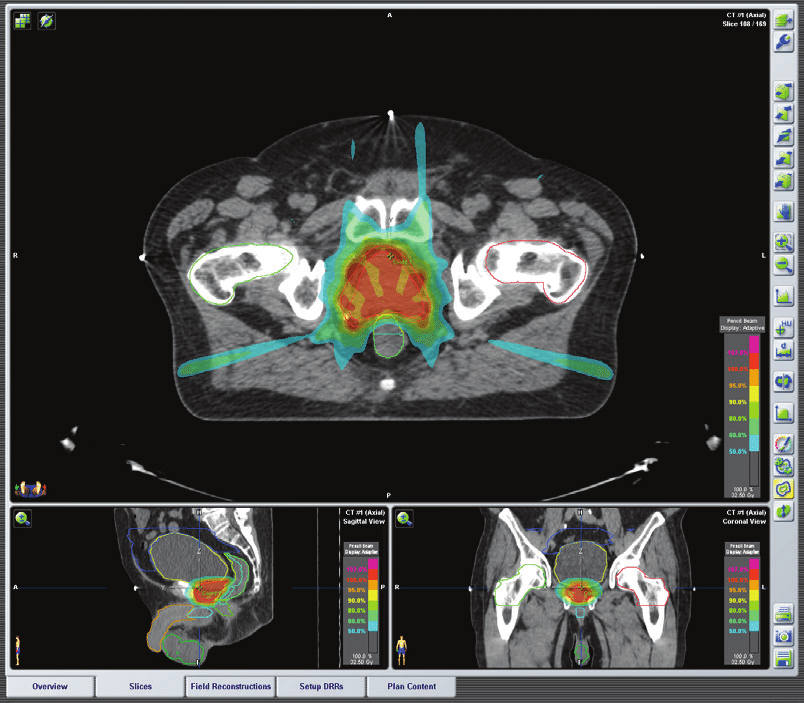It works by damaging the cancer cells and making it hard for them to reproduce. IMRT stands for intensity modulated beam radiation therapy and uses the electron beam implemented in both electron beam radiation therapy EBRT and 3 dimensional conformal radiation therapy 3D-CRT.
 Prostate Cancer Treatment Intensity Modulated Radiation Therapy Imrt Prostate Matters
Prostate Cancer Treatment Intensity Modulated Radiation Therapy Imrt Prostate Matters
Radiation therapy uses high-energy rays to treat cancer.

Imrt prostate cancer treatment. The most common form of radiation therapy is intensity-modulated radiation therapy IMRT in which a beam of radiation is aimed at the prostate for a short period of time. However your normal cells are able to repair themselves in a way that cancer cells cannot. This way they dont hit healthy tissue.
Radiation therapy also affects normal cells. Its a type of treatment for cancer. Small doses of radiation over several weeks can eradicate most prostate cancers Dr.
THE ROLE OF IMRT IN PROSTATE CANCER Intensity-modulated radiotherapy is the standard of care for head and neck cancers and it shows great promise for the treatment of certain brain and colorectal. IMRT Intensity Modulated Radiation Therapy. Recent studies have demonstrated that full coverage of the intended treatment target can be achieved while reducing doses to surrounding tissues with IMRT.
A type of external beam radiation therapy where your doctor uses a computer to plan the exact dose of radiation that is aimed at your prostate cancer. Historically I was not convinced there was a significant benefit to proton therapy for prostate cancer and felt that I was able to provide an unbiased opinion due to my training. Radiation therapy RT is a curative treatment modality for localized prostate cancer.
All men received IMRT which uses enhanced treatment planning software to target radiation to the prostate while attempting to spare surrounding healthy tissue. It allows the oncologist to treat prostate cancer with higher doses of radiation which is proven to improve the outcome while minimising the side-effects. Patients receive treatment five days a week for six weeks.
Intensity-modulated radiation therapy IMRT is a type of external beam radiation therapy EBRT used to treat prostate cancer patients. IGRT IMRT emerges as the preferred treatment option for a wide spectrum of prostate cancer patients. Over the past two decades advances in technology and imaging have considerably changed RT in prostate cancer treatment.
In IMRT doctors use a computer to send radiation right to the tumor. Currently there are only a few centers in the United States who offer IMRT as a prostate cancer radiation treatment. However based on the most recent scientific data as well as newer proton treatment techniques pencil beam scanning I now encourage men to consider proton therapy.
Treatment has evolved from 2-dimensional 2D planning using X-ray fields based on pelvic bo. The aim of this study was to analyse the impact of RT technique 3D-CRT vs IMRTVMAT on the incidence of second tumors in prostate cancer PCa patients. The Memorial Sloan Kettering Cancer MSKCC Group was one of the original clinical developers of IMRT technology for prostate cancer treatment and recently published their 10-year results indicating long-term effectiveness on a par with radical prostatectomy.
Your body then is naturally able to get rid of these damaged cancer cells. 3D-CRT is far more popular. IMRT stands for Intensity Modulated Radiation Therapy and has been the standard radiation treatment for prostate cancer for the past decade.
There are three ways radiation may be delivered to prostate cancer patients. A machine that allows you to talk between two rooms. It has been hypothesized that radiotherapy RT techniques delivering radiations to larger volumes IMRT VMAT are potentially associated with a higher risk of second primary tumors.
IMRT is an advanced type of therapy that manipulates beams of radiation to conform to the tumors shape with the goal of reducing the exposure of the healthy tissues surrounding the cancer. By a machine outside the body external beam radiation therapy by placing radioactive materials inside the body internal radiation therapy or brachytherapy and by ingesting radioactive substances systemic radiation therapy.
